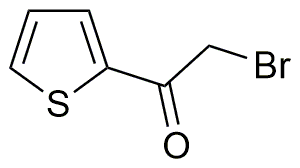2-(Bromoacetyl)thiophene is widely utilized in research focused on:
- Synthetic Chemistry: This compound serves as a key intermediate in the synthesis of various pharmaceuticals and agrochemicals, enabling the development of new drugs and crop protection agents.
- Material Science: It is used in the production of conductive polymers and organic semiconductors, which are essential for advanced electronic devices like organic light-emitting diodes (OLEDs).
- Biological Research: The compound is explored for its potential as a biochemical probe, helping researchers understand cellular processes and interactions, particularly in cancer research.
- Photochemical Applications: Its unique structure allows it to be utilized in photochemical reactions, making it valuable in the development of light-activated materials and systems.
- Environmental Chemistry: 2-(Bromoacetyl)thiophene is studied for its role in the synthesis of environmentally friendly pesticides, contributing to sustainable agricultural practices.
General Information
Properties
Safety and Regulations
Applications
2-(Bromoacetyl)thiophene is widely utilized in research focused on:
- Synthetic Chemistry: This compound serves as a key intermediate in the synthesis of various pharmaceuticals and agrochemicals, enabling the development of new drugs and crop protection agents.
- Material Science: It is used in the production of conductive polymers and organic semiconductors, which are essential for advanced electronic devices like organic light-emitting diodes (OLEDs).
- Biological Research: The compound is explored for its potential as a biochemical probe, helping researchers understand cellular processes and interactions, particularly in cancer research.
- Photochemical Applications: Its unique structure allows it to be utilized in photochemical reactions, making it valuable in the development of light-activated materials and systems.
- Environmental Chemistry: 2-(Bromoacetyl)thiophene is studied for its role in the synthesis of environmentally friendly pesticides, contributing to sustainable agricultural practices.
Documents
Safety Data Sheets (SDS)
The SDS provides comprehensive safety information on handling, storage, and disposal of the product.
Product Specification (PS)
The PS provides a comprehensive breakdown of the product’s properties, including chemical composition, physical state, purity, and storage requirements. It also details acceptable quality ranges and the product's intended applications.
Certificates of Analysis (COA)
Search for Certificates of Analysis (COA) by entering the products Lot Number. Lot and Batch Numbers can be found on a product’s label following the words ‘Lot’ or ‘Batch’.
*Catalog Number
*Lot Number
Certificates Of Origin (COO)
This COO confirms the country where the product was manufactured, and also details the materials and components used in it and whether it is derived from natural, synthetic, or other specific sources. This certificate may be required for customs, trade, and regulatory compliance.
*Catalog Number
*Lot Number
Safety Data Sheets (SDS)
The SDS provides comprehensive safety information on handling, storage, and disposal of the product.
DownloadProduct Specification (PS)
The PS provides a comprehensive breakdown of the product’s properties, including chemical composition, physical state, purity, and storage requirements. It also details acceptable quality ranges and the product's intended applications.
DownloadCertificates of Analysis (COA)
Search for Certificates of Analysis (COA) by entering the products Lot Number. Lot and Batch Numbers can be found on a product’s label following the words ‘Lot’ or ‘Batch’.
*Catalog Number
*Lot Number
Certificates Of Origin (COO)
This COO confirms the country where the product was manufactured, and also details the materials and components used in it and whether it is derived from natural, synthetic, or other specific sources. This certificate may be required for customs, trade, and regulatory compliance.


